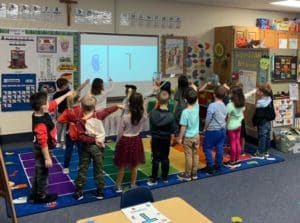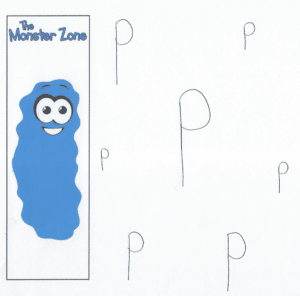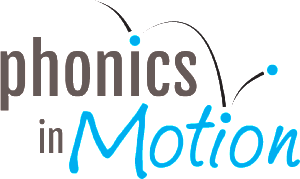Early Handwriting Skills: The Key To Positive Educational Outcomes
Developing strong early handwriting skills is a critical component of developing great readers and writers.
Tied directly to future educational outcomes, early handwriting skills contribute to the foundation of primary literacy.
Early handwriting skills are sometimes underestimated by parents and educators, but extensive research has been conducted in this area. The results demonstrate a clear literacy benefit to developing this skill quickly and point towards an increased need for explicit instruction in primary learning environments.
However, as parents and educators know, many children are resistant to practicing early handwriting skills. Their hand hurts, they’re upset that they wrote the letter wrong, and it can be just plain boring.
In the beginning, it takes a lot of effort for little reward in the mind of a primary learner. It is, of course, much more fun to jump around and play with your friends or build a castle with Lego. Providing consistent instruction and making letter formation practice exciting is the key to improved literacy outcomes.
Why is Letter Formation Important?
At the Norwegian University of Science and Technology, Professor Audrey van der Meer has been researching early handwriting skills and has stumbled across some interesting data.
This research is quite in-depth, measuring the brain activity of students as they practiced letter formations. They discovered discrepancies between the amount of brain activity required for early handwriting skills and keyboarding, which has gradually taken over in the educational space.
Van der Meer’s research shows that “The use of pen and paper gives the brain more ‘hooks’ to hang your memories on. Writing by hand creates much more activity in the sensorimotor parts of the brain. A lot of senses are activated by pressing the pen on paper, seeing the letters you write, and hearing the sound you make while writing. These sensory experiences create contact between different parts of the brain and open the brain up for learning. We both learn better and remember better,” says Van der Meer.
Repeated practice results in automation. Whether it is good or bad, repeated practice results in repeated action. Therefore, your proper modeling of correctly writing the letter is a critical first step in promoting literacy development.
How Do Early Handwriting Skills Impact Further Education?
There has also been significant discussion on whether early handwriting skills provide benefits in other areas of literacy. According to research by Brenda Rapp and Robert Wiley from John Hopkins University, the answer is “absolutely.”
Rapp and Wiley demonstrated that, since writing is a multi-sensory experience, it forms a stronger picture in the brain. From there, students can scaffold the abilities learned into other areas of education.
While long-term, in-depth research on childhood literacy prior to entering kindergarten is hard to find, Laura Dinehart from Florida International University cites that the ability to learn early handwriting skills before entering a formal school setting can strongly predict future academic achievement.
Why Do Students Struggle with Early Handwriting Skills?
When children are beginning to write, they have typically been shown the letter and have a decent idea of how they want their letter to look. But then, it comes out entirely differently. This is a common frustration amongst educators teaching early handwriting skills. We want to reduce those frustrations as often as possible. After many feelings of failure, it can be hard to try again.
- It can be hard to remember letter formations.
- It can be hard to remember where to start. If we don’t know where to start, how do we know where to go next?
- It can be hard to learn how to control a pencil.
- It is hard, frustrating, and tiring.
“Learning to write by hand is a bit slower process, but it’s important for children to go through the tiring phase of learning to write by hand. The intricate hand movements and the shaping of letters are beneficial in several ways. If you use a keyboard, you use the same movement for each letter. Writing by hand requires control of your fine motor abilities and senses. It’s important to put the brain in a learning state as often as possible.” says Van der Meer.
When early handwriting skills are not fluent, and a student gets caught up in the formation or reading a letter, they have instantly lost track of comprehension, meaning, and the context of what they’re writing. Instead, they’re trying to figure out what to do next. They’re stuck. Developing early handwriting skills results in the freedom of the brain to attend to the meaning of what is being read or written.
Tips for Teaching Early Handwriting Skills
Teachers share that they spend time on writing lessons and the results are good during the lesson, but when they look at their journals and independent practice worksheets, it’s almost like they’ve forgotten everything. They often wonder, “why isn’t it sticking? “
Well, when the lesson is over, there are no directions to lean on, and the modeling of examples is over. It makes sense that the results you see in their independent practice might not be as strong as what you observed during your modeled lesson or interactive practice.
This is not an uncommon scenario in a preschool or primary classroom, and one that both classroom educators and homeschooling parents often face. Early handwriting skills take time and persistence to improve, with an attention span that may not be fully developed. Luckily, Phonics in Motion realizes this and has zeroed in on techniques that make learning an interactive experience that sticks in students’ minds well after the teacher leaves the room.
There are some methods to improve the student’s relationship with early handwriting skills and increase muscle memory for future attempts:
Develop A Routine
As Van der Mere’s research shows, repetition is the key to developing successful early handwriting skills. Phonics in Motion places significant emphasis on creating and executing a routine. In The Complete Guide To Teaching With Phonics in Motion, Dr. Kindervater provides targeted methods to establish a solid routine.
Focus on the Elements of Letter Formation
 Explicit teaching of the mechanics of letter formation is essential to developing early handwriting skills. Showing exactly how to form each letter can help solidify the links between writing and reading, and can help skyrocket progress in all areas of foundational literacy.
Explicit teaching of the mechanics of letter formation is essential to developing early handwriting skills. Showing exactly how to form each letter can help solidify the links between writing and reading, and can help skyrocket progress in all areas of foundational literacy.
Be Clear, Concise, Predictable
Helping students understand exactly what is expected of them each time they pick up a pencil will improve early handwriting skills. Remove the risk associated with practicing by keeping the writing session predictable. Since children thrive on routine, providing a steady, engaging sequence to practice early handwriting skills will increase outcomes.
Celebrate Success
Your student finally wrote the letter “g” correctly for the first time? Celebrate. They almost got “e” this time, but not quite? Celebrate. Positive reinforcement and being proud of their efforts will continue to establish a positive and productive relationship with writing.
How Phonics in Motion Can Help Teach Primary Literacy
Some researchers say that it is important to teach children that they should expect letter formation to be harder when the teacher is not there and to comfort them around this. With Phonics in Motion’s writing strategy, things look a lot different. PIM doesn’t leave the learner hanging in this way.
 Why? The writing stories direct the learner on how to make their strokes. The language of these kid-approved stories directs their pencil. Soon, this becomes muscle memory.
Why? The writing stories direct the learner on how to make their strokes. The language of these kid-approved stories directs their pencil. Soon, this becomes muscle memory.
While we’re on the topic of the importance of scaffolds and supports that go far beyond your modeled or guided lesson, you should know that all four components of Phonics in Motion are designed to start with you as the model.
However, each becomes a tool, a reference, a guide that supports them wherever and whenever they are working on the skill you have taught them. Using PIM results in providing learners with the tools they need to develop reading and writing both when they are with you and when they are on their own. The writing stories are, in a way, extend both the direction and the modeling that the teacher’s lesson offered.
While other programs require kids to apply hard to remember language and instructions like “go up to the skyline…then go down,” PIM removes the need to understand and apply excess information so that the learner can solely focus on the task at hand, forming the letter.
Learning to write is hard enough as it is. Let’s make it easy. Let’s make it fun. Let’s make it muscle memory. And let’s build pathways in the brain with a daily writing routine! Here’s a sample handwriting story so you can see exactly how this can be done. By repeating the story as you write, and matching the language to the strokes, children know exactly what to do; even when you’re not there to help them!
Conclusion
The significance of developing early handwriting skills has been backed by some of the world’s top educational researchers. Phonics in Motion is based on sound research that has been proven to drive results in both a classroom and homeschool setting. By creating a fun, multi-sensory environment, Phonics in Motion allows for easier progress in early handwriting skills, limiting the power struggles and increasing outcomes.
Writing is an area that can impact all pillars of literacy, but it is often the skill that children resist the most. Infusing fun into learning is always Phonics in Motion’s underlying objective, and we are committed to supporting parents and educators every step of the way.
Based on the research and life’s work of Dr. Terry Kindervater, The Complete Guide To Teaching With Phonics in Motion provides comprehensive techniques and explanations into the science of primary literacy development, including early handwriting skills. This e-book is written to benefit any educational setting, as it includes clear instructional methods to follow with learners at any level.
Due to its focus on learning through kinesthetic movement, Phonics in Motion is the perfect place to start for nearly effortless learning instruction both at home and in the classroom. You can get a sneak peek of our research-backed e-book here.







